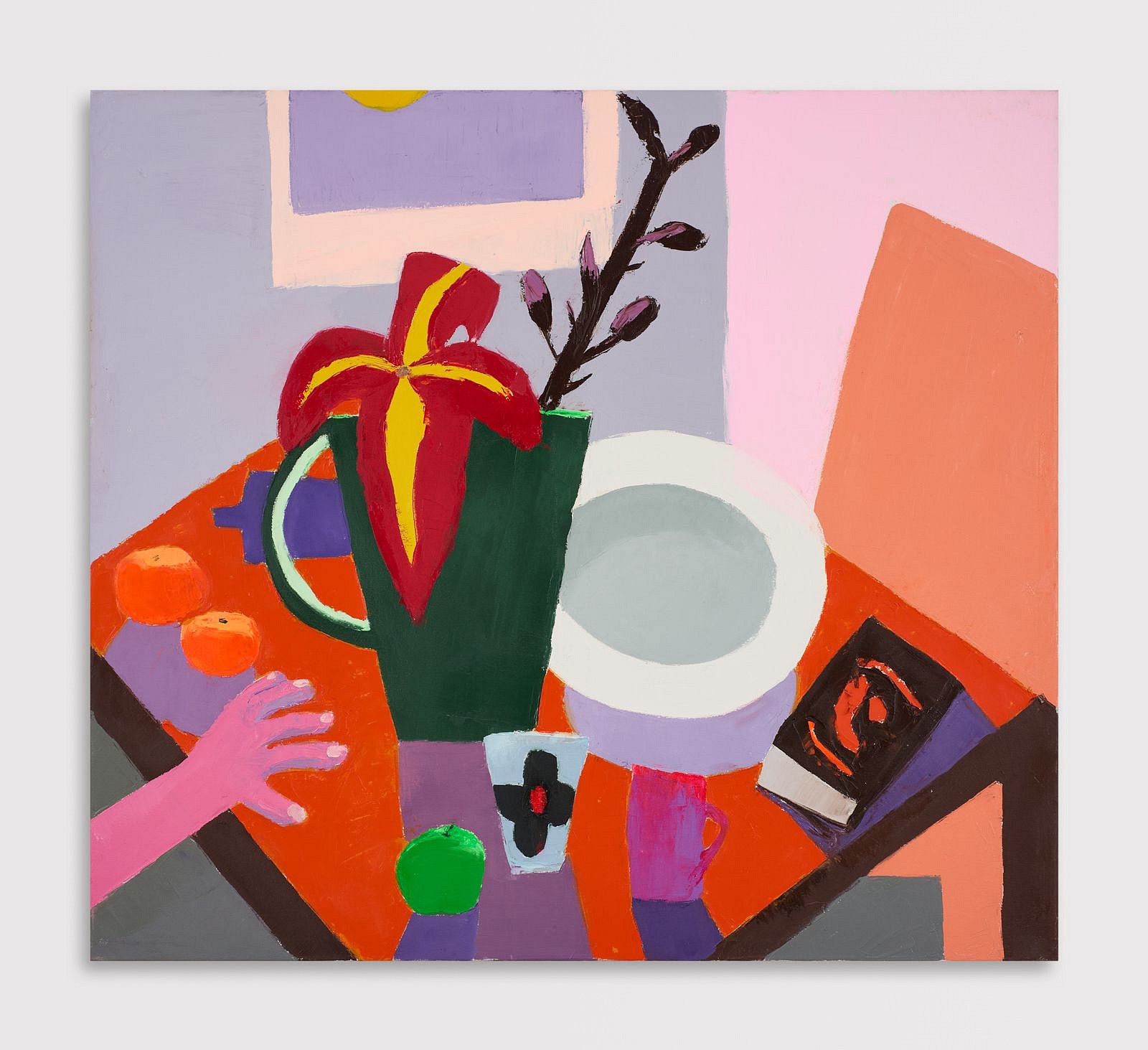PRESS RELEASE

In The Dead of Night | Collecting
Oct 23, 2025 – Jan 1, 2026
Curator: Hadas Glazer
Lilith Chambon: In the Dead of Night
Women in domestic spaces: sitting, relaxing, meditating, resting their heads next to fruits or flowers. Landscapes of lakes and hills in sunlight or a full moon that stretch outside these spaces seem to echo their quiet inner world. The figures exude a sense of distant intimacy, like a window into lucid dreams or the nebulous states between wakefulness and slumber. These women, the artist’s likeness, seem to signal us what a moment that does not need meaning looks like.
There are not too many things within these spaces; the items do not touch each other and each detail has its own place. The elements that appear alongside the figures, like celestial bodies, fruit, and a skull, imbue the painting with a subtle metaphysical air. The appearance of the bird in some of the paintings suggests a mystical link between the woman and the animal and alludes to the biblical myth of Lilith. The mythology and mysticism that permeate the paintings create a sense of a fictional plot or perhaps a moment from a complete story. However, this is not a painting of an event, but a painting of being: resting, dreaming, present figures. After a while in the exhibition, visitors are transported to a realm filled with color and light, where time seems to move at a different, slower pace.
In her choice of bold colors, the construction of the composition, and the perspective, Chambon draws inspiration from the fathers of European Modernism, while formulating her own personal and contemporary language within it. In that sense, she joins a generation of painters who engaged in a dialogue with Modernism, reread it, and reformulated it into a language for our time. The painting is done with the canvas laid down horizontally on the table, and only at the end of the process does Chambon hold the canvas upright and see the complete painting. The order of things is significant: It shifts focus to the colorful and formalist expression, builds the way the shadows fall, while also leaving space for chance. This leads to a painting where the fluorescent palette seems to light the works from the inside, like bright screens gleaming in the dark night. The fragmentation of the body and face, constructed out of crisp colorful shapes, lends itself to an image where the figure is simultaneously abstract and geometric.
In the end, we are left with an intentionally unfinished line of thought. There is no story, no decisive moment, but rather a continuous present in which color, light, and tone are the key players. The works invite the viewer to let go of the need to make sense and meaning and to take part in the comfort of being, which has become a luxury these days: To slip between the table and the curtain, rest our head, allow wandering thoughts to fade away, and find some respite, and perhaps also inner peace.
Yarin Didi: Collecting
The world that Yarin Didi creates is based on two principles: minimalism and attentiveness. First, material minimalism that relies on natural wood, where the color palette stems almost exclusively from the organic: The natural shades of the wood are maintained, and require careful observation of their nuances, rings, fibers, and hue shifts. Alongside them, he also uses the humble concrete and plaster, which are given an elevated status in the works. The second principle is manifested in Didi’s minimal intervention, which is done with as little touch as possible, with attention and respect for the organic aspects of his raw materials.
The minimalism of the action underscores a crucial aspect of the artist’s approach to the material: Didi collects the pieces of wood in natural forests or from discarded furniture; each piece of wood is selected after a long period of observing, contemplating, and waiting, when eventually, the intervention will involve minimal touch and the action will be precise, distinct, and tailored to that particular piece. The plaster and concrete mixtures fill the spaces between the trees, formulating a sculptural language that does not overpower the material, but rather responds to it, mends and revitalizes it.
Indeed, these works are not permanent, but rather inhabit the gap between the living and the inanimate. The almost magical connection between Didi and the wood he works with gives them a second life after they were felled. Through these, he participates in a dialogue that acknowledges a history of living, blooming, budding, and then felling, chopping, splitting, and sometimes – burning and drying in the oven.
The attitude is as much ethical as it is aesthetic: Who speaks for the tree, and what is the hierarchy in the human-material-environment relationship? Within this domain, material landscapes and gentle, mute or deaf figures take shape, ones whose communication is nonverbal, yet are physically and materially expressive.
Litvak’s new Project Room offers an intimate experience, where the large-scale and small works serve as each other’s habitats. The figures seem to come from a planet where touch, weight, and crevices replace sound. The expanse that unfolds between the figures, the abstract landscapes, and the artist, oscillates between the utopian and the documentary, posing questions about responsibility towards the world and towards those who are only able to make a hushed, hissed voice.
Installation Photography: Youval Hai.
Reproduction Photography: Youval Hai (Lilith Chambon); Yarin Didi.
Exhibition Catalogue:

